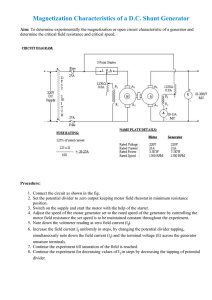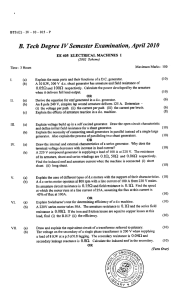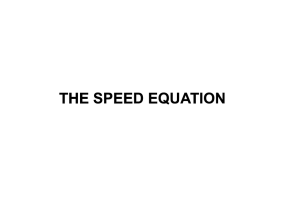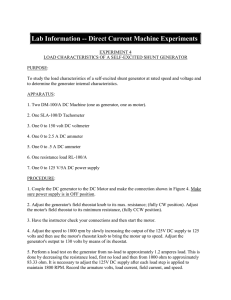dc generators - Sakshieducation.com
advertisement
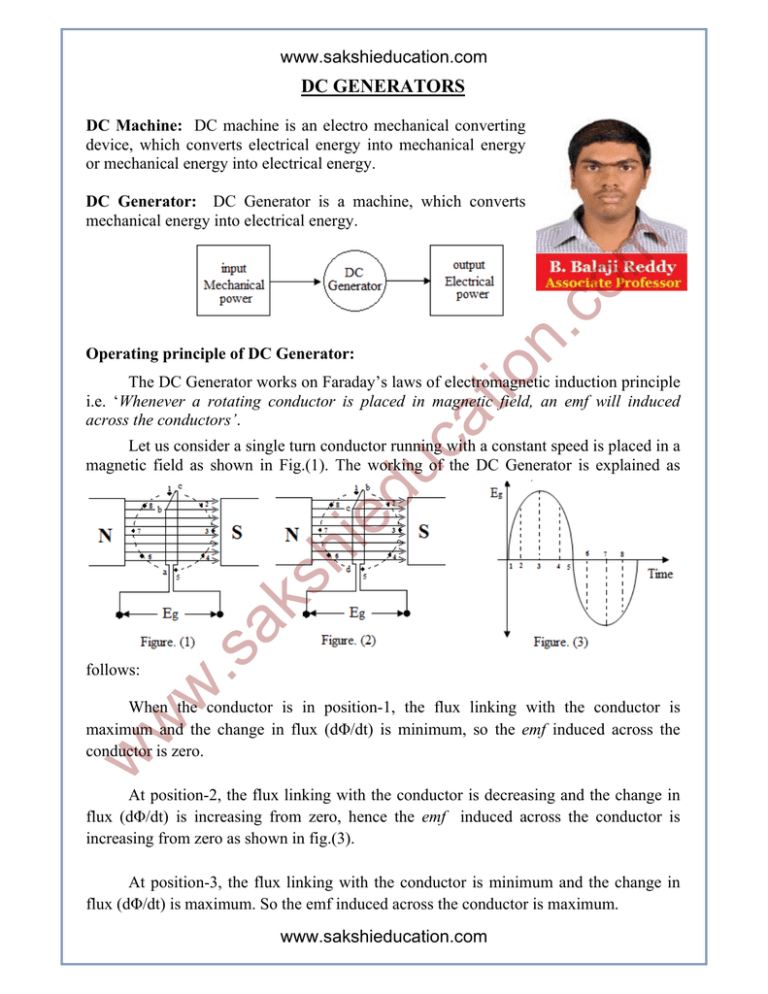
www.sakshieducation.com DC GENERATORS DC Machine: DC machine is an electro mechanical converting device, which converts electrical energy into mechanical energy or mechanical energy into electrical energy. ed uc at io n. co m DC Generator: DC Generator is a machine, which converts mechanical energy into electrical energy. Operating principle of DC Generator: The DC Generator works on Faraday’s laws of electromagnetic induction principle i.e. ‘Whenever a rotating conductor is placed in magnetic field, an emf will induced across the conductors’. w follows: .s a ks hi Let us consider a single turn conductor running with a constant speed is placed in a magnetic field as shown in Fig.(1). The working of the DC Generator is explained as w w When the conductor is in position-1, the flux linking with the conductor is maximum and the change in flux (dΦ/dt) is minimum, so the emf induced across the conductor is zero. At position-2, the flux linking with the conductor is decreasing and the change in flux (dΦ/dt) is increasing from zero, hence the emf induced across the conductor is increasing from zero as shown in fig.(3). At position-3, the flux linking with the conductor is minimum and the change in flux (dΦ/dt) is maximum. So the emf induced across the conductor is maximum. www.sakshieducation.com www.sakshieducation.com At position-4, the flux linking with the conductor is increasing from minimum and the change in flux (dΦ/dt) is decreasing from maximum value, hence the emf induced across the conductor is decreasing from maximum as shown in fig.(3). co m At position-5, the flux linking with the conductor is maximum and the change in flux (dΦ/dt) is minimum, so the emf induced across the conductor is minimum. ed uc at io n. At position-6, the flux linking with the conductor is decreasing and the change in flux (dΦ/dt) is increasing from zero, hence the emf induced across the conductor is increasing from zero as shown in fig.(3) but the direction of induced emf is negative from conductor position 5 to 1. Differences between lap and wave windings: hi Lap Winding Wave Winding 1. In Lap winding the finishing end of 1. The wave winding is designed like a the one coil is connected to starting wave end of the adjacent coil. 2. EMF generation is more because 2. EMF generation is low because no. of no. of conductors in parallel path is conductors in parallel path is less. more. 3. No. of parallel paths = No. of poles 3. No. of parallel paths = 2 .s a ks 4. It is suitable for low voltage and high current applications. 4. It is suitable for high voltage and low current applications. E.M.F. Equation of a D.C. Generator Let w φ = flux/pole in Wb P = number of poles w w Z = No. of armature conductors = No. of slots * conductors/slot A = No. of parallel paths = P ... for Lap winding = 2 ... for Wave winding N = Speed of armature in r.p.m. Eg = Generated EMF or EMF/parallel path According to faraday’s laws of electromagnetic induction principle, average induced EMF (Eg) = dφ/dt Where dφ = Flux cut by a conductor in one revolution = Pφ wb www.sakshieducation.com www.sakshieducation.com dt = Time taken to complete one revolution Since N no. of revolutions are made by the generator per minute, no. of revolutions are made by the generator per sec = N / 60 1 = 60/N (Ns/60) PΦ PΦ N = (60/N) 60 Average value of induced EMF /conductor = co m ∴ Time taken to complete one revolution (dt) = The DC generator has Z no. of armature conductors and are divided into A no. of parallel paths, then no. of conductors per each parallel path is Z/A. PΦ N Z * A 60 ed uc at io n. ∴ Induced EMF per each parallel path = Induced EMF (or) Generated EMF (Eg) = Φ ZN P * 60 A Where A = No. of parallel paths = P for lap winding =2 for wave winding Types of D.C. Generators DC Generators are generally classified into two, according to their field excitation. Those hi are ks (i) Separately excited d.c. generators .s a (ii) Self-excited d.c. generators (i) Separately Excited D.C. Generator: w w w The d.c. generator whose field winding is excited from an independent external d.c. source (battery) is called a separately excited generator. Fig.4 shows the connections of a separately excited generator. The separately excited d.c. generators are rarely used in practice. and Eg = Vt + Ia Ra + B.D From the diagram Ia = IL Figure 4 Electrical power developed = Eg Ia and Power delivered to load = Vt IL = Vt Ia www.sakshieducation.com www.sakshieducation.com Where Ia = Armature current, Ra = Armature Resistance, Vt = Terminal voltage, IL = Load current And B.D = Brush contact drop (ii) Self excited D.C. Generator co m The d.c. generator whose field winding is excited by itself is called a self-excited generator. There are three types of self-excited generators, namely; (i) DC Shunt generator (ii) DC Series generator (iii) DC Compound generator DC Shunt generator From the diagram, Shunt field current Ish = Vt / Rsh ed uc at io n. In a DC Shunt Generator, the field windings are connected in parallel with the armature winding as shown in fig (5). The shunt field winding has many turns of thin wire having high resistance, therefore, a part of the armature current flows through shunt field winding and the remaining current flows through the load. Armature current Ia = IL + Ish (or) IL = Ia - Ish Generated EMF Eg = Vt + Ia Ra + B. D Terminal voltage Vt = Eg - Ia Ra - B. D hi Power developed in armature = Eg Ia Ia = Armature current, Ra = Armature .s a Where ks Power delivered to load = Vt IL = Vt (Ia – Ish) Resistance, Vt = Terminal voltage, IL = Load current And B.D = Brush contact drop w DC Series generator w w If the field winding is connected in series with armature winding as shown in fig.(6) is called DC Series Generator. The series field winding has a few turns of thick having low resistance. The DC Series generators are rarely used except for special purposes e.g., as boosters. From the circuit, Armature current = Series field current = Load current i.e Ia = Ise = IL Generated EMF Eg = Vt + Ia Ra + Ise Rse + B. D www.sakshieducation.com www.sakshieducation.com = Vt + Ia (Ra + Rse) + B. D ∴ Terminal voltage, Vt = Eg – Ia (Ra + Rse) - B. D Power developed in armature = Eg Ia Power delivered to load = Vt IL = Vt Ia (since Ia = IL) Where, co m Ia = Armature current, Ra = Armature Resistance, Vt = Terminal voltage, ed uc at io n. IL = Load current and B.D = Brush contact drop DC Compound generator: In a DC compound generator, there are two sets of field windings on each pole, one is in series with the armature and the other in parallel with the armature. Based on these field winding connections, the DC compound generators are classified into (i) Long shunt compound generator (ii) Short shunt compound generator .s a From the diagram, ks hi Long shunt compound generator In a Long Shunt Compound generator, the shunt field winding is in parallel with the both series field and the armature winding as shown in fig. (7). Shunt field current Ish = Vt / Rsh w Armature current Ia = Ise = IL + Ish (or) IL = Ia - Ish w w Generated EMF Eg = Vt + Ia Ra + Ise Rse + B. D = Vt + Ia (Ra + Rse) + B. D Terminal voltage Vt = Eg - Ia (Ra + Rse) - B. D Power developed in armature = Eg Ia Power delivered to load = Vt IL = Vt (Ia – Ish) Where, Ia = Armature current, Ra = Armature Resistance, www.sakshieducation.com www.sakshieducation.com Vt = Terminal voltage, IL = Load current and B.D = Brush contact drop Short shunt compound generator co m In a Short Shunt Compound generator, the shunt field winding is connected in parallel with armature winding only, as shown in fig. (8). From the diagram Armature current Ia = Ise + Ish Shunt field current Ish = Vt + IseRse Rsh ed uc at io n. Series field current Ise = IL and Generated EMF Eg = Vt + Ia Ra + Ise Rse + B. D Terminal voltage Vt = Eg - Ia Ra - Ise Rse) - B. D Power developed in armature = Eg Ia Power delivered to load = Vt IL = Vt (Ia – Ish) Ia = Armature current, ks Ra = Armature Resistance, hi Where Vt = Terminal voltage, .s a IL = Load current and w B.D = Brush contact drop w w Magnetization or Open Circuit Characteristic (O.C.C.) This curve shows the relation between the generated e.m.f. at no-load (E0) and the field current (If) at constant speed. It is also known as magnetic characteristic or no-load www.sakshieducation.com www.sakshieducation.com saturation curve. Its shape is practically the same for all generators whether separately or self excited. The data for O.C.C. curve are obtained experimentally by operating the generator at no load and constant speed and recording the change in terminal voltage as the field current is varied. ed uc at io n. The following points may be noted from O.C.C: co m The O.C.C. for a d.c. generator is determined as follows: The field winding of the d.c. generator (series or shunt) is separately excited from an external d.c. source as shown in Fig. (9). Now the field current (If) is increased from zero in steps and the corresponding values of generated e.m.f. (E0) are noted. Now plot the graph between E0 and If to get the open circuit characteristic as shown in Fig.(10). (i) When the field current is zero, there is some generated e.m.f. OA. This is due to the residual magnetism in the field poles. (ii) Upto certain range of field current (upto point B in the curve), the curve is linear, because reluctance of iron is negligible as compared with that of air gap. The air gap reluctance is constant and hence linear relationship. hi (iii) After point C on the curve, the poles get saturated and hence the magnetic flux varies slowly with field current. ks Characteristics of Shunt Generator Open Circuit Characteristic (O.C.C.): w w w .s a This curve shows the relation between the generated e.m.f. at no-load (E0) and the field current (If) at constant speed. It is also known as magnetic characteristic or no-load saturation curve. Its shape is practically the same for all generators whether separately or self-excited. The data for O.C.C. curve are obtained experimentally by operating the generator at no load and constant speed and recording the change in terminal voltage as the field current is varied. The O.C.C. for a d.c. shunt generator is determined as follows. www.sakshieducation.com www.sakshieducation.com The field winding of the d.c. shunt generator is separately excited from an external d.c. source. Now the field current (If) is increased from zero in steps and the corresponding values of generated e.m.f. (E0) are noted. On plotting the graph between E0 and If, we get the open circuit characteristic as shown in Fig.(11). Load Characteristic co m The load characteristics of DC shunt generator are classified as Internal characteristics and External characteristics. ed uc at io n. Internal characteristics Internal characteristics are drawn between the generated e.m.f. on load (Eg) and the armature current (Ia). When the generator is loaded, the flux per pole is reduced due to armature reaction. Therefore, e.m.f. generated (Eg) on load is less than the e.m.f. generated (E0) at no load. As a result, the internal characteristic (Eg Vs Ia) falls down slightly as shown in Fig.(12). hi External characteristics The External characteristics are drawn between terminal voltage Vt and load current IL. We know that terminal voltage Vt = Eg – Ia Ra . As the load on the generator increases, the armature voltage drop (Ia Ra) increases, this result in decrease in terminal voltage (Vt) from rated value as shown in fig. (12). The External characteristic always lies below the Internal characteristics. The load characteristics of a DC Shunt Generator are called Drooping characteristics. ks Characteristics of Series Generator .s a Open Circuit Characteristic (O.C.C.) w w w The open circuit characteristics are drawn between the generated e.m.f. at no-load (E0) and the field current (If) at constant speed. It is also known as magnetic characteristic or no-load saturation curve. The data for O.C.C. curve are obtained experimentally by operating the generator at no load and constant speed and recording the change in terminal voltage as the field current is varied. The O.C.C. for a d.c. series generator is determined as follows. The field winding of the d.c. series generator is separately excited from an external d.c. source. Now the field current (If) is increased from zero in steps and the corresponding values of generated e.m.f. (E0) are noted. On plotting the graph between E0 and If, we get the open circuit characteristic as shown in Fig.(13). www.sakshieducation.com ed uc at io n. co m www.sakshieducation.com Load Characteristic The load characteristics of DC series generator are classified as Internal characteristics and External characteristics. hi Internal characteristics Internal characteristics are drawn between the generated e.m.f. on load (Eg) and the armature current (Ia). When the generator is loaded, the flux per pole is reduced due to armature reaction. Therefore, e.m.f. generated (Eg) on load is less than the e.m.f. generated (E0) at no load. Consequently, internal characteristic curve lies below the O.C.C. curve as shown in fig. (14). w w w .s a ks External characteristics The External characteristics are drawn between terminal voltage Vt and load current IL or Ia or Ise. We know that terminal voltage Vt = Eg – Ia (Ra + Rse) . As the load on the generator increases, the armature voltage drop Ia (Ra + Rse) increases, this result in decrease in terminal voltage (Vt). Therefore the External characteristic always lies below the Internal characteristics. The load characteristics of a DC Series Generator are called Rising characteristics. www.sakshieducation.com

